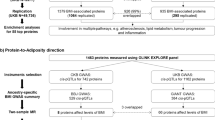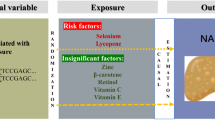Abstract
This study investigated the association between single nucleotide polymorphisms (SNPs) in AdipoQ, +45 T > G and +276 G > T, and adiponectin levels in the Korean Chinese population in Yanbian, China. A total of 329 subjects were involved in this study, including 178 female and 151 male individuals. All of them are ethnic Koreans living in Yanbian, aged from 31 to 70, and 58 % of them were diagnosed with type 2 diabetes (T2D). Items tested and calculated include total cholesterol (TC), triglyceride (TG), high-density lipoprotein cholesterol (HDL-C), low-density lipoprotein cholesterol (LDL-C), fasting plasma glucose (FPG), body fat percentage (BF%), fasting plasma insulin (FPI), plasma adiponectin (PA), and homeostasis model assessment of insulin resistance (HOMA-IR). SNPs were screened with the method of SNaPshot. P < 0.05 was defined as the statistically significant threshold. Results include the following: (1) PA levels in the T2D group are much lower than those in the normal group (P < 0.001); (2) the distribution of genotypes of SNPs +45 T > G and +276 G > T was determined to be in Hardy-Weinberg equilibrium (P > 0.05) and complete linkage disequilibrium (|D′| = 1.0); (3) PA levels in females are much higher than those in males no matter which group they belong to (normal or T2D group) (P = 0.004 and P = 0.018); (4) PA levels are higher in the individuals with +45G as a dominant allele than those in individuals with homozygous genotype TT at locus +45 in the normal group (P = 0.037); and (5) of SNPs +45 T > G and +276 G > T, no risk factor of genotype or allele was found (P > 0.05). Three conclusions can be drawn: (1) PA levels are lower in T2D patients than in normal persons; (2) PA levels are higher in females than in males; (3) PA levels are higher for normal individuals with +45G allele than those with homozygous TT genotype at locus +45 in AdipoQ.
Similar content being viewed by others
References
Sheng T, Yang K. Adiponectin and its association with insulin resistance and type 2 diabetes. J Genet Genomics. 2008;35:321–6.
Renaldi O, Pramono B, Sinorita H, Purnomo LB, Asdie RH, Asdie AH. Hypoadiponectinemia: a risk factor for metabolic syndrome. Acta Med Indones. 2009;41:20–4.
Su H, Lau WB, Ma X-L. Hypoadiponectinemia in type 2 diabetes: molecular mechanisms and clinical significance. Clin Exp Pharmacol Physiol. 2011;38:897–904.
Abdelgadir M, Karlsson AF, Berglund L, Berne C. Low serum adiponectin concentrations are associated with insulin sensitivity independent of obesity in Sudanese subjects with type 2 diabetes mellitus. Diabetol Metab Syndr. 2013;5:15.
Gu HF. Biomarkers of adiponectin: plasma protein variation and genomic DNA polymorphisms. Biomark Insights. 2009;4:123–33.
Li Y, Li X, Shi L, Yang M, Yang Y, Tao W, et al. Association of adiponectin SNP + 45 and SNP + 276 with type 2 diabetes in Han Chinese populations: a meta-analysis of 26 case-control studies. PLoS One. 2011;6:e19686.
Wang B, Wang C, Wei D, Zhang J, He H, Ma M, et al. An association study of SNP + 45 T > G of the AdipoQ gene with type 2 diabetes in Yi and Han people in China. Int J Vitam Nutr Res. 2011;81:392–7.
Rodriguez S, Gaunt TR, Day INM. Hardy-Weinberg equilibrium testing of biological ascertainment for Mendelian randomization studies. Am J Epidemiol. 2009;169:505–14.
Gaunt TR, Rodríguez S, Day INM. Cubic exact solutions for the estimation of pairwise haplotype frequencies: implications for linkage disequilibrium analyses and a web tool “CubeX.”. BMC Bioinformatics. 2007;8:428.
American Diabetes Association. Standards of medical care in diabetes - 2012. Diabetes Care. 2012;35:S11–63.
Duncan BB, Schmidt MI, Pankow JS, Bang H, Couper D, Ballantyne CM, et al. Adiponectin and the development of type 2 diabetes—the atherosclerosis risk in communities study. Diabetes. 2012;53:2473–8.
Snehalatha C, Mukesh B, Simon M, Viswanathan V, Haffner SM, Ramachandran A. Plasma adiponectin is an independent predictor of type 2 diabetes. Diabetes Care. 2003;26:3226–9.
Krakoff J, Funahashi T, Stehouwer CDA, Schalkwijk CG, Tanaka S, Matsuzawa Y, et al. Inflammatory markers, adiponectin, and risk of type 2 diabetes in the Pima Indian. Diabetes Care. 2003;26:1745–51.
Dainon M, Oizumi T, Saitoh T, Kameda W, Hirata A, Yamaguchi H, et al. Decreased serum levels of adiponectin are a risk factor for the progression to type 2 diabetes in the Japanese population. Diabetes Care. 2003;26:2015–20.
Lindsay RS, Funahashi T, Krakoff J, Matsuzawa Y, Tanaka S, Kobes S, et al. Genome-wide linkage analysis of serum adiponectin in the Pima Indian population. Diabetes. 2003;52:2419–25.
Dresner A, Laurent D, Marcucci M, Griffin ME, Dufour S, Cline GW, et al. Effects of free fatty acids on glucose transport and IRS-1-associated phosphatidylinositol 3-kinase activity. J Clin Invest. 1999;103:253–9.
Mao X, Kikani CK, Riojas RA, Langlais P, Wang L, Ramos FJ, et al. APPL1 binds to adiponectin receptors and mediates adiponectin signalling and function. Nat Cell Biol. 2006;8:516–23.
Li H, Xiao Y, Liu H, Chen X-Y, Li X-Y, Tang W, et al. Hypoadiponectinemia predicts impaired endothelium-independent vasodilation in newly diagnosed type 2 diabetic patients: an 8-year prospective study. Chin Med J (Engl). 2011;124:3607–12.
Tsai J-S, Wu C-H, Chen S-C, Huang K-C, Chen C-Y, Chang C-I, et al. Plasma adiponectin levels correlate positively with an increasing number of components of frailty in male elders. PLoS One. 2013;8:e56250.
Mackevics V, Heid IM, Wagner SA, Cip P, Doppelmayr H, Lejnieks A, et al. The adiponectin gene is associated with adiponectin levels but not with characteristics of the insulin resistance syndrome in healthy Caucasians. Eur J Hum Genet. 2006;14:349–56.
Hara K, Boutin P, Mori Y, Tobe K, Dina C, Yasuda K, et al. Genetic variation in the gene encoding adiponectin is associated with an increased risk of type 2 diabetes in the Japanese population. Diabetes. 2002;51:536–40.
Menzaghi C, Ercolino T, Salvemini L, Coco A, Kim SH, Fini G, et al. Multigenic control of serum adiponectin levels: evidence for a role of the APM1 gene and a locus on 14q13. Physiol Genomics. 2004;19:170–4.
Acknowledgments
This study was funded by the National Natural Science Foundation of China (No. 31060154).
Conflict of interest
There is no conflict of interest.
Author information
Authors and Affiliations
Corresponding author
Rights and permissions
About this article
Cite this article
Sheng, T., Cui, Z., Zhou, W. et al. Association between SNPs in AdipoQ, +45 T > G and +276 G > T, and adiponectin levels in the Korean Chinese population in Yanbian, China. Int J Diabetes Dev Ctries 36, 401–406 (2016). https://doi.org/10.1007/s13410-015-0353-9
Received:
Accepted:
Published:
Issue Date:
DOI: https://doi.org/10.1007/s13410-015-0353-9




